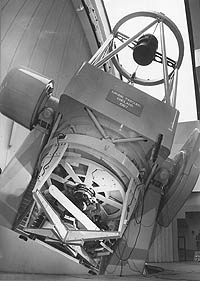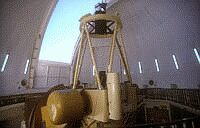 | |||
|
| Home > Public Information > Isaac Newton Telescope > History of the INT |
History
In his Presidential Address to the Royal Astronomical Society (RAS) in 1946, Prof. H.H. Plaskett posed the question of whether a large British telescope should ever be sited in Britain itself. The astronomers were taking stock after the war as such projects became at least possible again. The Empire did provide high, clear sites for observatories; South Africa had played that role in the Cape of Good Hope and with the Radcliffe Telescope in Pretoria, but there was still a desire for a bigger, local instrument.
When Plaskett answered his question affirmatively, events moved with astonishing speed, and the idea was presented to the House of Commons later that year. Moreover, from the beginning of this project, the Isaac Newton Tercentenary Committee (he was born in 1642 but WWII postponed 1942 activities) had been involved and would name the telescope in his honor.
The classical Cassegrain had a 2.49-m f/3 parabolic Pyrex primary mirror; there was an observer’s cage and camera at prime focus. The cage could be swapped with an 0.5-m secondary with an f/14 Cassegrain focus or another secondary with an f/32 Coud&eeacute; focus one floor below the telescope. It was carried on an equatorial fork mount which was supported by a pier 15 m above ground level.
Important work was done in astrometry and spectrometry for 14 years at Herstmonceux; it stimulated the development of a deep cadre of astronomers that was ready to move on to a darker, drier, higher environment. Eventually, the marginal conditions in Sussex, the advent of affordable air travel, the benefits of a high mountain top site, and the success of other international consortia led the INT's management to transplant it to La Palma in 1979, but after a slightly larger, 2.54-m f/3.29 Zerodur primary from Grubb Parsons and a new mount were installed, it was hardly the same telescope! The two secondaries provide f/15 Cassegrain and f/50 Coud&eeacute;.
The mechanical structure of the
INT was shipped to La Palma in 1981 and was re-erected into the bare frame
of its building in 1982. The mirror arrived on the island on December 10,
1982; the building was handed over by the contractors to the RGO on January
17, 1983 and work began on preparing the laboratories and workshops for
the commissioning of the telescope. The first of three direct air shipments
of machinery, instruments and computers arrived on La Palma on January
25. By September the building was in full operation and the telescope was
fully assembled, with a freshly aluminised mirror, by the end of the year.
On the first night of February 1984 stars were first seen in the telescope,
at the prime focus. The telescope commissioning programme had been targeted
towards the completion of the Cassegrain spectrograph since this would
be the most widely demanded instrument; it was also tolerant to telescope
pointing and tracking. In the spring of 1984 there was a concentrated effort to commission the Cassegrain instrumentation, including acquisition TV cameras, Intermediate Dispersion Spectrograph (IDS), IPCS and CCD detectors and ADAM, the software environment which brings together this complex of instruments into one working station. This programme was completed in May. On May 29 1984, the telescope welcomed its first scheduled astronomer. It operated for astronomers for 47% of the time in the first six-month period (Semester F), 50% in semester G, 62% in Semester H and 73% in Semester I. The rest of the time was used for engineering work. The born-again INT at La Palma, differs significantly in its mechanics, electronics and optics from the earlier incarnation at Herstmonceux: The change in latitude from 50 degrees 51 minutes 58 seconds to 28 degrees 45 minutes 43.4 seconds resulted in a large change of angle to the polar disc which stands almost on edge. A segment was removed from the disc in order to allow operation to a declination of -30 degrees.
The optical telescope assembly weighs 51.4 kg. Including the mounting, it weighs 85.4 kg. The INT hosted two major instruments: WFC (Wide Field Camera) was at prime focus and has a 40 arcmin field of view captured with a four CCD camera. It has proven extremely productive as a survey telescope. IDS (Intermediate Dispersion Spectrograph) was installed at the Cassegrain focus with a 20 arcmin field of view. Both the WFC and the IDS saw last light in 2024 as the INT is upgraded with the next item. HARPS-3 (High Accuracy RV Planet Searcher -3) is an upgrade of previous HARPS at the 3.6-m ESO telescope and at the TNG nearby at ORM, and is intended to reach 10 cm/sec radia-velocity accuracy. It will be fiber-fed to the Coude Lab and the spectrograph will be in a very cold and stable cryostat. It will include a polarimeter and be highly robotised, with first spectra in the mid 2020s. The INT has been active in the discovery of near-earth asteroids, supernovae, and stellar-size black holes. It also functions as a scout telescope for the larger WHT at the ORM. Currently, The Observatory Science Centre runs an extensive programme of activities in the former location of the INT Telescope in Herstmonceux. Some interesting articles on the INT include:
|
| Top | Back |
|



